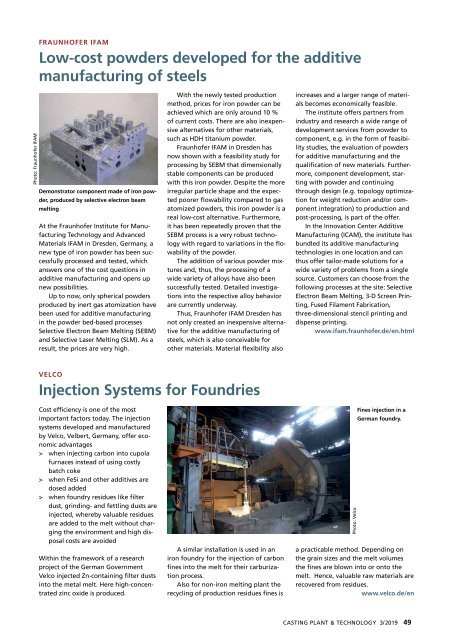You also want an ePaper? Increase the reach of your titles
YUMPU automatically turns print PDFs into web optimized ePapers that Google loves.
FRAUNHOFER IFAM<br />
Low-cost powders developed for the additive<br />
manufacturing of steels<br />
Photo: Fraunhofer IFAM<br />
Demonstrator component made of iron powder,<br />
produced by selective electron beam<br />
melting<br />
At the Fraunhofer Institute for Manufacturing<br />
Technology and Advanced<br />
Materials IFAM in Dresden, Germany, a<br />
new type of iron powder has been successfully<br />
processed and tested, which<br />
answers one of the cost questions in<br />
additive manufacturing and opens up<br />
new possibilities.<br />
Up to now, only spherical powders<br />
produced by inert gas atomization have<br />
been used for additive manufacturing<br />
in the powder bed-based processes<br />
Selective Electron Beam Melting (SEBM)<br />
and Selective Laser Melting (SLM). As a<br />
result, the prices are very high.<br />
With the newly tested production<br />
method, prices for iron powder can be<br />
achieved which are only around 10 %<br />
of current costs. There are also inexpensive<br />
alternatives for other materials,<br />
such as HDH titanium powder.<br />
Fraunhofer IFAM in Dresden has<br />
now shown with a feasibility study for<br />
processing by SEBM that dimensionally<br />
stable components can be produced<br />
with this iron powder. Despite the more<br />
irregular particle shape and the expected<br />
poorer flowability compared to gas<br />
atomized powders, this iron powder is a<br />
real low-cost alternative. Furthermore,<br />
it has been repeatedly proven that the<br />
SEBM process is a very robust technology<br />
with regard to variations in the flowability<br />
of the powder.<br />
The addition of various powder mixtures<br />
and, thus, the processing of a<br />
wide variety of alloys have also been<br />
successfully tested. Detailed investigations<br />
into the respective alloy behavior<br />
are currently underway.<br />
Thus, Fraunhofer IFAM Dresden has<br />
not only created an inexpensive alternative<br />
for the additive manufacturing of<br />
steels, which is also conceivable for<br />
other materials. Material flexibility also<br />
increases and a larger range of materials<br />
becomes economically feasible.<br />
The institute offers partners from<br />
industry and research a wide range of<br />
development services from powder to<br />
component, e.g. in the form of feasibility<br />
studies, the evaluation of powders<br />
for additive manufacturing and the<br />
qualification of new materials. Furthermore,<br />
component development, starting<br />
with powder and continuing<br />
through design (e.g. topology optimization<br />
for weight reduction and/or component<br />
integration) to production and<br />
post-processing, is part of the offer.<br />
In the Innovation Center Additive<br />
Manufacturing (ICAM), the institute has<br />
bundled its additive manufacturing<br />
technologies in one location and can<br />
thus offer tailor-made solutions for a<br />
wide variety of problems from a single<br />
source. Customers can choose from the<br />
following processes at the site: Selective<br />
Electron Beam Melting, 3-D Screen Printing,<br />
Fused Filament Fabrication,<br />
three-dimensional stencil printing and<br />
dispense printing.<br />
www.ifam.fraunhofer.de/en.html<br />
VELCO<br />
Injection Systems for Foundries<br />
Cost efficiency is one of the most<br />
important factors today. The injection<br />
systems developed and manufactured<br />
by Velco, Velbert, Germany, offer economic<br />
advantages<br />
> when injecting carbon into cupola<br />
furnaces instead of using costly<br />
batch coke<br />
> when FeSi and other additives are<br />
dosed added<br />
> when foundry residues like filter<br />
dust, grinding- and fettling dusts are<br />
injected, whereby valuable residues<br />
are added to the melt without charging<br />
the environment and high disposal<br />
costs are avoided<br />
Within the framework of a research<br />
project of the German Government<br />
Velco injected Zn-containing filter dusts<br />
into the metal melt. Here high-concentrated<br />
zinc oxide is produced.<br />
A similar installation is used in an<br />
iron foundry for the injection of carbon<br />
fines into the melt for their carburization<br />
process.<br />
Also for non-iron melting plant the<br />
recycling of production residues fines is<br />
Photo: Velco<br />
Fines injection in a<br />
German foundry.<br />
a practicable method. Depending on<br />
the grain sizes and the melt volumes<br />
the fines are blown into or onto the<br />
melt. Hence, valuable raw materials are<br />
recovered from residues.<br />
www.velco.de/en<br />
CASTING PLANT & TECHNOLOGY 3/<strong>2019</strong> 49

















